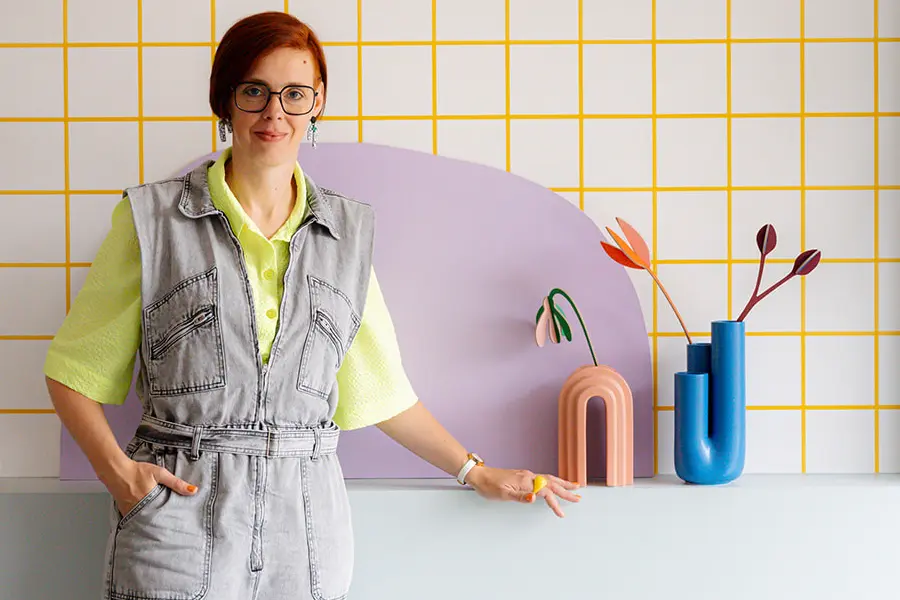No products in the basket.

Share

In her work, a Lancashire born and London based contemporary painter Rebecca Tucker explores a unique and delicate balance between abstraction and representation. Rebecca enjoys examining opposites within her work, in particular the contrast of loose, expressive brushstrokes overlaid with drawn lines and painstaking fine brush work. Her work also plays on positive and negative spaces, layering abstraction with something more recognisable.
Here we chat with Rebecca about her journey as an artist so far …
Tell us more about your journey into the art world.
It didn’t really occur to me, after graduating with a Fine Art degree from the University of Reading in 1996, to even try and take on a career as an artist. The 90’s were an amazing time to study art, the YBAs were making their mark, conceptual art was in it’s heyday, so it was all very exciting, but as a painter I felt like I was working on the sidelines, especially as my practice has always been involved with aesthetics and abstraction, and was not politically or culturally motivated.
So, whilst I continued to paint, my focus went towards finding a creative industry to thrive in. Initially working in retail merchandising and moving into interior design offered me the creativity outlet I needed, and I have run a multi-award winning interior design business since 2001.
Twenty plus years (and two children) later, Covid hit and although the business continued successfully through the whole of the lockdown period, I gained time back from school runs, taxiing to school clubs, commuting to the office and travelling to meetings and found myself with time on my hands, two teenaged kids who didn’t need me looking over their shoulder, and a studio in the garden that I had never really had the time to commit to. And I haven’t looked back. I now work part time in my business, and commit the rest of my week to painting and all that goes with that.


How would you describe your signature style and technique?
I have always been fixated with the spectrum between abstraction and representation, or more precisely, with the viewer’s perception of representation.
My whole degree show was focused on the use of a single horizontal line on a canvas, and how that automatically allows the viewer to perceive a landscape and from that go further to read mood, atmosphere, geographic location into what they ‘see’.
More recently this has widened into more detailed studies of negative space, denoting shapes and features relating to the natural and built world. So leaves, and trees, buildings and landmarks. But once I have a ‘subject’ the whole process of painting works against that subject to bring you back to looking at paint on a two dimensional surface.
I want to play with depth of field and perspective, suggesting these with tone and colour and the drawn line but then counteracting it with the exact same means. So a white shape that depicts sky through leaves can seem to float forward depending on what colour it sits on, and becomes something other than sky. It becomes abstract. In simple terms, I take my subjects and work in various ways and to various degrees to abstract them. How far I go towards abstraction changes from piece to piece.
When it comes to materials I am all about layers and transparency. I use materials that I can dilute and play with. Inks and acrylics, watered down to allow for experimentation and chance to play it’s part in the process. Then layering on a drawn element, often using carbon paper or similar so that I am drawing ‘blind’ onto an expressive abstract background. Then using a top layer denoting negative space. The results are always surprising, even to me. I love that about my process. I can’t plan it. I go with the process and see what happens.



Can you tell us about your latest work? Where did you find inspiration and what is the story behind it?
I am currently working with a few different strands to my practice, a year of the Turps Off Site Programme has taught me not to try and define things or channel any ideas too quickly, to let ideas percolate and develop in their own time. So I currently have ethereal ink paintings of striped fabric and children’s clothes that have something nostalgic and maternal about them.
I have large scale mightily colourful abstracts overlaid with drawn lines and white shapes of negative space. And I have more monochrome layered paintings, reminiscent of a misty light, almost photographic. And then I have a hundred ideas spinning in my head at any one time, using geographic and historic references for a series of work about medieval fortified cities, using fairytales and simplified abstracts to denote my feelings about motherhood and childhood and children flying the nest, using pin point images of locations and painting what is there, finding beauty in the ‘ugly’. On and on! Not all will come to something but I have realised that my practice is as much about working through these ideas as it is about the end result.


Are there any exhibitions or events you are planning in near future?
I have my first art fair stand at The Other Art Fair 7 -10th March at the Truman Brewery and I am in a group show at the Irving Gallery, Oxford through March until 12th April. I have a piece selected for the Royal Watercolour Society Open at Bankside Gallery from 8th to 24th March.
Then a self-curated group show with five other artists at the Regency Town House in Brighton in April. Then exhibitions with ArtCan at Bermondsey Project Space and Landmark Arts Centre and we are planning another ArtCan curating project Downstairs at The Department Store in the Autumn, after the massive success of last years 125+ artists exhibition that I co-curated there. This year is looking like it might be a very busy time!
What is the best advice you’ve been given as an artist?
I am a very ‘grass-is-greener’ person, and have to try hard not to look at others and wish I could emulate their practice. In that vein, I have always thought I needed to narrow down my practice, be one of those artists with a single strand of consistent output (and a beautifully curated Insta feed!).
A year of the Turps Programme made me realise that this is the exact opposite of what I need to do. On my first session with my Turps mentor, Adam Hennessey, he asked ‘why?’ I thought I needed to narrow things down and I realised I was aspiring to something that was just so opposite to how I work that I would never achieve it. And if I did achieve a single style of output then I would not be particularly happy.
I need variety and experimentation and a constant forward motion, only then will strands start to meet each other, cross over and cross pollinate and allow exciting things to happen. So I have learnt to give myself time to go off down random tangents of thought, to not try and refine things too soon, to experiment and fail, to be open to the opportunity for something to surprise me. To play to my own strengths and not to the strengths I perceive in others.

For more information please visit rebeccatucker.co.uk
DISCOVER ANOTHER ARTIST STORY HERE.
WHY NOT LOOK AT BOBCAT GALLERY ARTIST STORIES HERE TOO?
Sign up to our newsletters and we’ll keep you in the loop with everything good and important going on in the worlds of design, art and independent retail.
By subscribing you agree to receive updates from ESTILA. We will not share your data with any third parties. Read our full privacy policy here.

We are a media and membership platform for design-led brands, interior designers and artists. Find latest industry news, insights, products, projects and contacts.
Join our “In the Loop” fortnightly design & art newsletter and never miss latest news from the industry.
CONNECT & LEARN
Copyright © 2015-2024 created and managed by STUDIO/ESTILA. All rights reserved | Terms & Conditions | Privacy Policy | Cookie Policy | Refund Policy